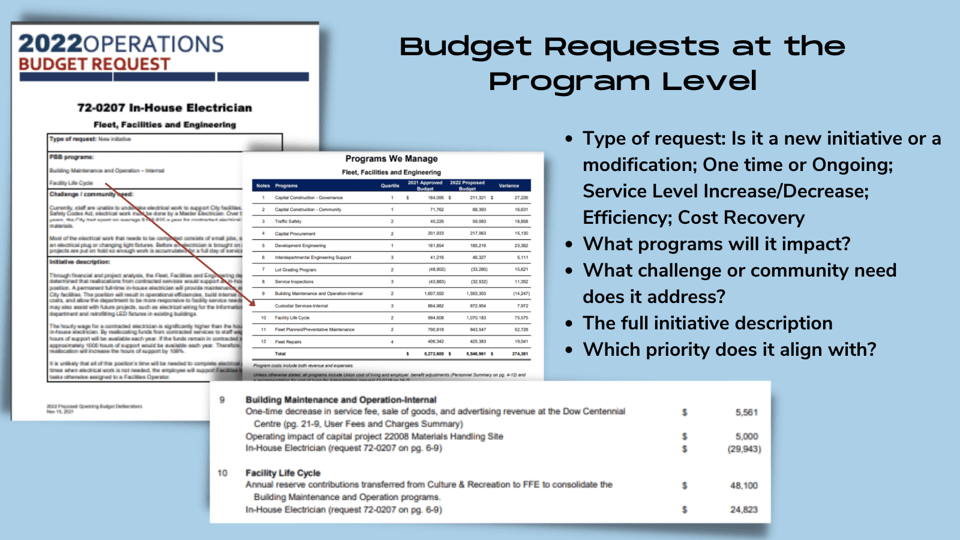Local government budgeting and planning processes are more complicated than ever. To keep pace with the needs of the community, budgets need to address everything from potholes and building permits to climate change and equity.
A common thread running through it all is how to create a budget that is both fiscally sustainable and agile. Line item budgets lack the visibility and flexibility needed to identify the community’s most important programs and services, allocate funding as needed, and pivot when necessary by reallocating funds and identifying new revenue sources.
Priority-based budgeting shifts thinking from line items to alignment with priorities, which accelerates the short- and long-term impact of local government budgets on programs and outcomes.
How Priority-Based Budgeting Increases Agility
Priority-based budgeting uses program data to connect resources with the community’s highest priorities. Because priority-based budgets are based on current community needs and available resources instead of the previous year’s expenditures, this approach increases agility in the budgeting process in four key ways.
Aligns Resources and Funding with Community Priorities and Outcomes
When governments regularly assess and reassess the needs of the community it is easier to identify inefficiencies, waste, and underserved programs and services. Tracking program results, soliciting community feedback, and involving government employees across all departments are effective ways to align funding at the program level.
Creates Actionable Data That Can Be Used to Drive Decisions
Looking at budget data from a programmatic viewpoint rather than at the line item level provides a 360-degree view of the resources that go into a program or service, including personnel, non-personnel, and revenue. This information is critical to help administrators identify the value and costs of specific services so that they can reallocate resources as needed.
Organizes the Budget in Terms That Are Relevant to How Residents Experience Local Government Services
Context is key to creating budgets that meet the biggest needs of a community. Priority-based budgeting helps residents understand the decisions driving the budget by breaking them down into programs that identify what the government does rather than simply listing line item expenditures that have no context.
Creates Transparency into Where Public Funds Are Used and How They Align with What Is Important to the Community
A local government budget isn’t truly agile if it isn’t meeting the community’s changing needs. Priority-based budgeting provides full transparency into which programs are being funded, how much they cost, and whether they are having the intended community impact. This level of insight builds trust with residents and holds the government accountable for results.
Cities are Letting Go of the Line Item Budget
Here are a few real-world examples of how shifting from line items to alignment with priorities increases agility and results in huge benefits to the community.
Crisis Staffing in Boise, Idaho
In 2020, operational agility became mandatory as local governments were forced to pivot overnight to maintain essential services and programs. The city of Boise, Idaho embraced priority-based budgeting as a means to adapt to providing services remotely.
Using priority-based budgeting software, city officials could quickly compile program data that allowed them to make staffing decisions based on which programs were mandatory to maintain, which had the highest impact on safety, and which had the highest impact on the economy.
Modernizing Operating and Capital Budgets in Fort Saskatchewan
The city of Fort Saskatchewan, Alberta has been making continuous forward movement in its operating and capital budgeting process using the priority-based budgeting solution OnlinePBB.
OnlinePBB provides a framework for evaluating the city’s more than 200 unique programs and capital project options to help leaders make decisions about resource allocation based on identifying which programs bring the most significant value to the community, optimizing service delivery, and maximizing value for tax dollars.
Fort Saskatchewan has seen such significant results from priority-based budgeting that city leaders now present budgets program-first, with supporting line items relegated to an appendix for reference purposes.
Empowering leaders to think programmatically in Littleton, Colorado
Littleton’s Pick 3 program is proof that a priority-based approach to budgeting doesn’t have to be complicated to succeed.
City leaders asked each department to pick two programs (the city manager picked the third) out of the 500 programs the city previously identified. The departments then applied the PBB BluePrint to answer future-focused questions about the programs, including:
- Will it benefit the community if we invest more into this program and increase service levels?
- Does this program provide an opportunity to divest resources away through efficiency, partnership, or service level reduction in order to reallocate those resources to a different program?
- Does this program provide revenue maximization opportunities, such as cost recovery or in-sourcing a regional solution?
This exercise empowered department leaders to think programmatically and present data-supported recommendations for service-level increases and decreases based on their alignment with the city's priorities.
Executing a strategic plan in Rowlett, Texas
Rowlett’s city leaders adopted a strategic plan to establish the government’s vision, mission, core values, strategic priorities, and goals. The strategic plan was designed to focus the city’s resources on the elements most valued by the community. However, they struggled to balance priorities with competing needs.
By implementing priority-based budgeting, the city manager’s office can now clearly see which programs and services are being funded, who benefits from those programs, and how those services can be provided more efficiently.
This information is used to support the city’s strategic plan by prioritizing how public resources are allocated and determining what actions should be taken to achieve successful outcomes.
Measuring the Impact of Priority-Based Budgeting
More and more local governments are looking beyond the line item for new, more effective approaches to creating agile and sustainable budgets.
Download the 2022 Impact Report to find out how priority-based budgeting supports these goals and which cities are seeing significant, measurable results after switching their budgetary focus from line items to programs and outcomes.








